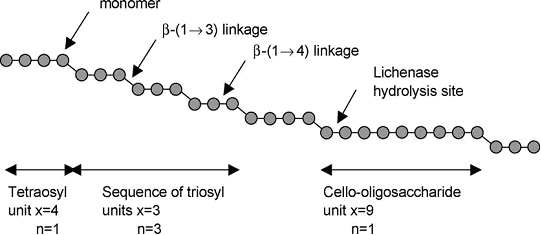
The application and the mechanism of beta-glucanase
Cereal beta-glucan, a structural component of subaleurone and endosperm cell walls of the seeds of cereal such as oat, wheat, barley and rye, is a linear non-starch polysaccharide composed of beta-D-glucopyranose (beta-D-glcp) as the primary building block. As shown in Figure 1, oat and barley demonstrated a relatively higher content of beta-glucan, and oat showed the highest content of beta-glucan among these cereal[1-2]. In feed, brewing and other industries, the high viscosity and stability of beta-glucan in solution usually cause the ineffective decomposition of cereal substrates, which in turn results in a high content of non-starch polysaccharide that negatively increase the viscosity of beer wort, decrease stability of beer, reduce malt digestion, and result in other anti-nutritional factors. Therefore, beta-glucanase is often used in feed, brewing and other industries in order to digest beta-glucan so that the content of cereal beta-glucan can be largely reduced and a better physicochemical and nutritional property can be achieved.

Fig1 The content of beta glucan in cereal products
Beta-glucanase is an endo-glycosidase that is specific for (1,3) and (1,4) linked beta-D-glucopyranosyl units. Figure 2 showed the basic structure of cereal beta-glucan and the mechanism of effect of glucanase. In figure 2, the shade circle, dash and arrow represent the glucose unit, glycosidic bond and the site of enzyme digestion, respectively. It has been reported that 90% of cereal beta-glucan is arranged as blocks of three or four consecutive (1,4)-linked units separated by (1,3)-linkage, the remaining 10% of the polymer chain is mainly composed of longer consecutive (1,4)-linked sequences ranged from 5 up to 14 beta-D-glcp residues. When a beta-glucanase acts on the substrate containing beta-glucan, the beta-glucan can be digested into oligosaccharides and monosaccharides in a time-dependent manner because of the specificity of beta-glucanase.

Fig2 Schematic diagram of the structure of cereal beta glucan and the lichenase hydrolysis site.
(cited from Susan M., Yolanda B., Peter J., Wang Q., John W., 2004)
Methods to determine the activity of glucanase
The principle to determine the activity of glucanase is to measure the change of substrate, such as the increased content of hydrolyzed sugar (reducing sugar) or decreased viscosity. Three methods are often used to determine the activity of glucanase: 1. Spectrophotometric method (to determine the content of reducing sugar in the substrate). The basic principle of this method is to use DNS (3,5-dinitrosalicylic acid) to react with reducing sugar (It is an color reaction that can be measured qualitatively and quantitively by spectrometer) released by glucanase. This method of measuring the reducing sugar content by spectrophotometry has been widely used due to its simplicity, accuracy and high repeatability. 2. Viscosity method (to determine the viscosity of substrate). Viscosity method has the advantage that the experiments can be conducted under a condition close to in vivo environment, but the drawbacks are this method is time consuming and hard to quantify. 3. Staining method. The principle of this relatively new method is to stain the substrate with artifical color, then the enzyme activity can be calculated through a determination of the change of color. Although this method is supposed to be more accurate than the other two, yet it has not been widely accepted because of the difficulty of control and reproducible of results.
The selection of cereal beta-glucan as substrate for the determination of beta-glucanase activity
The beta-glucan from oat, wheat and barley have the similar basic structure. They are only identified by the ratio of trisaccharide to tetrasaccharide units. It has been demonstrated that the ratio of trisaccharide and tetrasaccharide units identify the beta-glucan from a particular grain. The tri/tetrasaccharide ratio for beta-glucan from wheat, barley and oats are 4.5, 3.0 and 2.3, respectively[1,2]. Will such difference of trisaccharide/tetrasaccharide ratio among cereal (oat, wheat, barley) beta-glucans affect their application as the substrate for beta-glucanase?
Based on the mechanism of action of the glucanase, it is obvious that the hydrolysis depends on the style of glycosidic linkage of the substrate, not the ratio of trisaccharide to tetrasaccharide. On the other hand, the activity of glucanase is defined as the amount (umol) of reducing sugar released by glucanase at pH 4.5 and 45 and represented by U. Therefore, since the beta-glucans from various grains are only identified by the tri/tetrasaccharide ratio, such structural difference does not affect their application as the substrate to determine the activity of glucanase. As long as the beta-glucan is pure enough and less oligosaccharides contented, it can determine the activity of glucanase accurately.
The characteristic of Putus Oat beta glucan Standards and its application
Nowadays, only a few kinds of pure beta-glucan, offered by Sigma and Merck, can be used as substrate for beta-glucanase. Because of its high price, it undoubtedly increases the cost of glucanase, and limited the application of glucanase in feed and brewing industries. Some other enzyme companies use homemade glucan as substrate although the purity is not acceptable.
Putus Macromolecular Sci. & Tech. Ltd. is an international corporation which has been putting effort in research, development and application of a variety of carbohydrate polymers. Putus manufactures and provides high quality carbohydrate polymer standards with unique structure and high chemical uniformity in terms of molecular weight (Mw) and degree of branching.
Oat beta-glucan provided by Putus was extracted from the seeds of oat and demonstrated to be a linear glucan composed of mixed glycosidic linkages (1,3, and 1,4) in a highly purified environment without any starch and protein detected. We provide three kinds of glucans with different viscosity and molecular weight, i.e. high, medium and low, which are suitable as substrate for beta glucanase test in different methods.
Reference
[1] Choct M., Annison G. Anti-nutritive activity of wheat pentosans in broiler diets. British Poultry Science. 1990, 31: 811-822.
[2] Susan M., Yolanda B., Peter J., Wang Q., John W. Evaluation of Structure in the formation of gels by structurally diverse (1,3)(1,4)-beta-D-glucans from four cereal and one lichen species. Carbohydrate Polymers. 2004, 57: 249-259

 .
.